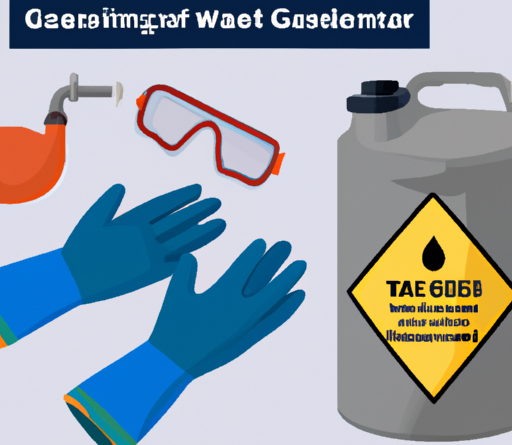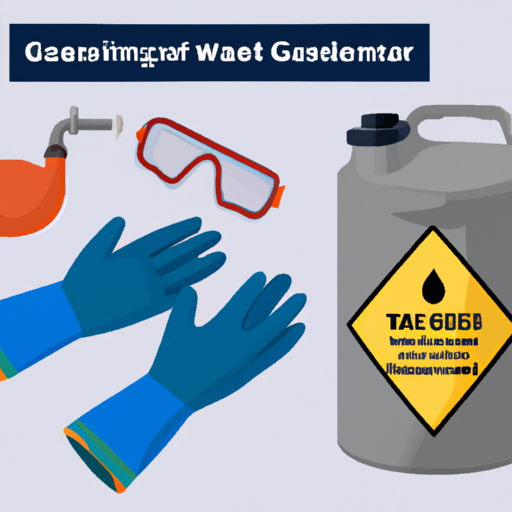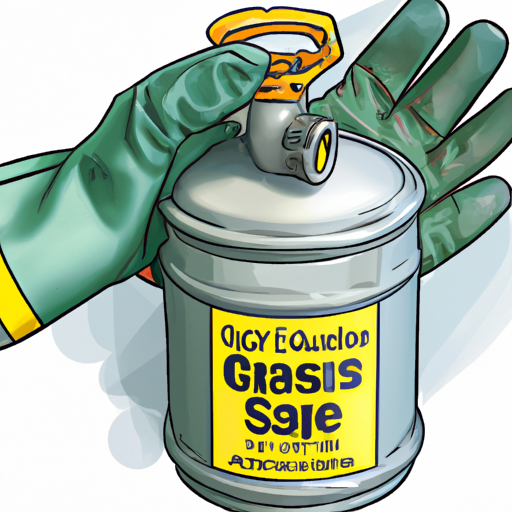
Have you ever found yourself in a situation where you needed to use a gas can but weren’t exactly sure how? Well, you’re in luck because in this article, we’ll be discussing how to safely use a gas can. Whether you’re filling up a lawnmower, a generator, or even a vehicle, these tips will ensure that you handle the task with utmost safety and efficiency.
First and foremost, it’s important to choose the right type of gas can for the job. There are different sizes and designs available, so make sure you select one that is appropriate for your specific needs. Once you have the right gas can, be sure to read and follow all the instructions provided by the manufacturer. Pay close attention to any warnings or precautions mentioned.
When you’re ready to use the gas can, find a well-ventilated area, preferably outdoors. Make sure you are wearing appropriate protective gear, such as gloves and safety goggles, to prevent any accidental spills or splashes. Position the gas can on a stable and level surface before opening it. Remember to never smoke or have any open flames nearby while handling gasoline. To learn more about the safe use of a gas can, continue reading our detailed article.
Table of Contents
How to Safely Use a Gas Can
Gasoline is a highly flammable substance, and improper handling of gas cans can lead to accidents and hazards. Whether you need to fill up your lawnmower, generator, or any other gasoline-powered equipment, it is important to follow the correct procedures to use a gas can safely. This article will guide you through each step, ensuring that you handle, store, and dispose of gasoline properly.
Step 1: Choose the Right Type of Gas Can
Understanding the Different Types of Gas Cans
Gas cans come in various types, each designed for specific purposes. The two common types are metal and plastic gas cans. Metal gas cans are generally more durable and suitable for heavy-duty use, but they can be heavier and prone to rust. On the other hand, plastic gas cans are lightweight, resistant to rust, and may come with built-in features like spouts and vents. Consider your specific needs and choose the type of gas can that suits you best.
Considering the Capacity and Material
When selecting a gas can, you should also consider its capacity and material. Gas cans come in different sizes, ranging from one gallon to five gallons or more. Choose a size that suits your needs without being too heavy to handle. Additionally, ensure that the gas can is made of sturdy and durable material to prevent leaks and spills.
Check for Safety Certifications
Before purchasing a gas can, check if it meets the necessary safety standards and certifications. Look for safety features like flame arrestors and child-resistant caps. Flame arrestors help prevent flashbacks and explosions, while child-resistant caps protect curious little hands from accidentally accessing the gasoline. Always prioritize safety when selecting a gas can.
Step 2: Prepare the Gas Can and Environment
Inspect the Gas Can for Any Damage
Before use, thoroughly inspect the gas can for any signs of damage. Look for cracks, dents, or leaks, as they can compromise the integrity of the container. If you find any damage, do not use the gas can and replace it immediately. It is essential to start with a gas can that is in good condition to avoid accidents and spills.
Ensure Proper Ventilation in the Area
When handling gasoline, it is crucial to have proper ventilation in the area. Gasoline vapors are highly flammable and can quickly ignite in an enclosed space. Avoid filling up gas cans in a confined area such as closed garages or basements. Instead, choose an outdoor location with sufficient air movement. This will help dissipate any gas fumes and reduce the risk of ignition.
Keep Away from Ignition Sources
Ensure that the area where you handle gas cans is free from any potential ignition sources. Avoid sparks, open flames, cigarettes, or any electrical equipment that could produce a spark. Gasoline vapors can easily ignite, and a small spark can lead to a serious fire or explosion. Always exercise caution and keep ignition sources far away from the gas cans.

Step 3: Fill the Gas Can Safely
Choose a Safe Location for Filling
When filling up your gas can, select a safe location away from buildings, vehicles, or any other flammable objects. It is essential to have a clear and level surface to minimize the risk of spills. Ensure that the gas pump nozzle and the gas can opening are in contact to prevent static electric sparks. Hold the nozzle firmly and avoid any distractions while filling, as spills can occur if you don’t pay attention.
Avoid Overfilling the Gas Can
Never overfill a gas can. It is crucial to leave some room for expansion, as gasoline expands when exposed to heat. Overfilled gas cans can spill easily, increasing the risk of fire or contamination. Fill the gas can slowly, and once it reaches the proper capacity, stop filling immediately. It’s better to err on the side of caution and not overfill the gas can.
Use a Funnel for Neat and Controlled Pouring
To minimize spills and ensure controlled pouring, it is recommended to use a funnel when transferring gasoline from the gas can to your equipment. A funnel helps direct the flow of gasoline and reduces the chances of spills or splashes. Make sure the funnel is clean and free from any debris or contaminants to avoid contamination of the gasoline.
Step 4: Secure the Gas Can Properly
Close the Gas Can Lid Tightly
After filling or using the gas can, always close the lid tightly. This will prevent any gasoline fumes from escaping and minimize the risk of ignition. A loose or improperly closed lid can lead to gas leaks and increase the chances of accidents. Take a moment to ensure the lid is securely closed each time you finish using the gas can.
Ensure the Cap is Ventilated
Some gas cans have vented caps to allow proper airflow and minimize pressure build-up inside the can. It is essential to ensure that the cap is ventilated correctly. A vented cap helps prevent the gas can from expanding or contracting with temperature changes, reducing the chances of leaks or spills. Follow the manufacturer’s instructions to ensure proper ventilation.
Store the Gas Can Upright
When not in use, store your gas can upright in a well-ventilated area away from direct sunlight or heat sources. Gas cans should be kept in a cool and dry place to prevent deterioration and to maintain their integrity. Avoid storing gas cans near any ignition sources or flammable materials. Always prioritize safety when storing gasoline.

Step 5: Transport with Caution
Secure the Gas Can in your Vehicle
If you need to transport a gas can in your vehicle, it is important to do so safely. Place the gas can on the floor of your vehicle, preferably behind the front seat. Ensure that the gas can is stable and will not tip over during transportation. Secure it with a seatbelt, bungee cord, or any other suitable method to prevent movement.
Keep the Gas Can Away from Passengers
Never transport a gas can in the passenger compartment of your vehicle. Gasoline fumes can be harmful, and any spills or leaks can lead to dangerous situations. It is crucial to keep the gas can in a well-ventilated area away from passengers. Transporting gasoline safely requires careful consideration to protect yourself and your passengers.
Follow Local Transportation Regulations
Always comply with local transportation regulations when transporting gas cans. Different jurisdictions may have specific rules and guidelines regarding transporting flammable substances. Research and familiarize yourself with the applicable regulations to ensure you are in compliance and reduce the risk of legal issues or accidents.
Step 6: Handle and Store with Safety
Always Use Proper PPE (Personal Protective Equipment)
When handling gasoline or gas cans, it is essential to use proper personal protective equipment (PPE). Wear gloves to protect your hands, safety goggles to shield your eyes, and clothing that covers your skin to minimize exposure. PPE acts as a barrier and reduces the risk of skin contact or accidental ingestion of gasoline.
Keep Gas Can Away from Children and Pets
It is crucial to store gas cans out of reach of children and pets. Gasoline is highly toxic and can be lethal if ingested. Keep gas cans in a locked cabinet, shed, or garage that is inaccessible to curious children and pets. Educate your family members about the dangers of gasoline and the importance of staying away from gas cans.
Avoid Storing Gas Cans Indoors
Gasoline should never be stored indoors unless you have a proper storage cabinet designed for flammable substances. Gasoline vapors are highly flammable and can quickly ignite in an enclosed space. Store gas cans in a well-ventilated area, preferably outdoors, to minimize the risk of fire or explosion.
Step 7: Emergency Preparedness
Have a Fire Extinguisher Nearby
Being prepared for emergencies is crucial when handling gasoline. Always have a fire extinguisher nearby in case of accidental fires or spills. Make sure you are familiar with how to operate the fire extinguisher properly. Prompt action can help contain small fires and prevent them from escalating into larger, more dangerous situations.
Know the Emergency Shutdown Procedures
Familiarize yourself with the emergency shutdown procedures for any gasoline-powered equipment you use. In case of a fire or other emergencies, knowing how to shut down the equipment quickly can prevent further damage or injuries. Read the equipment manual and understand the procedures thoroughly before operating any gasoline-powered machinery.
Plan for Spill Control and Cleanup
Despite taking precautions, spills can still happen. It is important to have supplies on hand to control and clean up spills effectively. Keep absorbent materials such as sand or kitty litter nearby to contain and soak up any spilled gasoline. A spill kit specifically designed for gasoline spills is also a wise investment. Prompt cleanup reduces slip and fire hazards.
Step 8: Dispose of Unused Gasoline Properly
Check Local Regulations for Disposal
When you have unused gasoline that you no longer need, it is crucial to dispose of it properly. Check with your local authorities to understand the regulations and guidelines for gasoline disposal in your area. Improper disposal can harm the environment and pose a risk to human health.
Consider Using Qualified Recycling Centers
Qualified recycling centers or hazardous waste facilities are often the best option for disposing of unused gasoline safely. These facilities have the expertise and equipment to handle and recycle gasoline properly. Contact your local recycling center or hazardous waste facility for guidance on how to properly dispose of unused gasoline.
Do Not Pour Gasoline Down the Drain or Sewer
Under no circumstances should you pour gasoline down the drain or sewer. Gasoline is highly toxic and can contaminate water sources, harm aquatic life, and damage sewage treatment systems. Disposing of gasoline in this manner is not only illegal but also poses significant environmental risks.
Step 9: Regularly Inspect and Maintain Gas Cans
Check for Leaks or Damages
Regularly inspect your gas cans for any signs of leaks, damages, or wear and tear. Look for cracks, rust, or loose fittings that could result in spills or accidents. If you detect any issues, repair or replace the gas can immediately to ensure safe storage and transportation of gasoline.
Replace Aging or Faulty Gas Cans
Gas cans, like any other equipment, have a limited lifespan. If your gas can is aging and showing signs of wear, it’s time to replace it. Faulty gas cans can pose risks and compromise safety. Invest in a new gas can that is in good condition and meets the necessary safety standards.
Keep Gas Cans Clean and Free from Contaminants
Maintain cleanliness and keep your gas cans free from contaminants. Dirt, debris, or residue from previous spills can contaminate the gasoline or cause blockages in the spout. Clean your gas cans regularly with mild soap and water, ensuring that they are thoroughly dry before use. This practice ensures the gasoline remains clean and uncontaminated.
Conclusion
Using gas cans safely is essential for avoiding accidents and hazards. By following these steps, you can ensure safe handling, storage, and disposal of gasoline. Always prioritize safety, be aware of local regulations and guidelines, and take the necessary precautions to protect yourself, your loved ones, and the environment. Remember, accidents can be prevented through proper education and adherence to the recommended procedures. Stay safe and handle gas cans with care.

